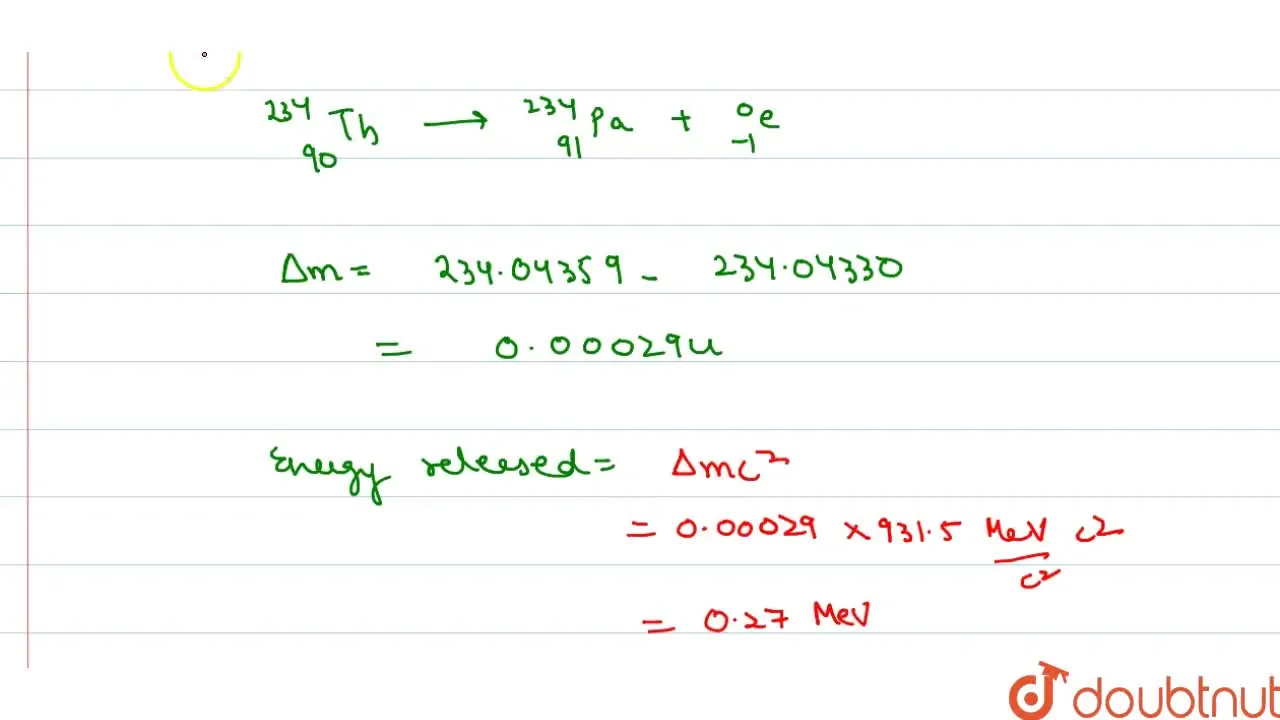The atomic mass of thorium .23490Th is 234.04359u, while that of protactinium .23491Pa is 234.04330u. Find the energy released when β decay changes 23490Th into
To find the energy released, we follows the usual procedure of determining how much the mass has decreased because of the decay and then calculating the equivalent energy. The decay and the masses are shown below:
.23490Th234.04359u→.23491Pa+.01e234.04330 u
When the .23490Th nucleus of a thorioum atom is converted into a .23491Pa nucleus, the number of orbital electrons remains the same, so the resulting protactinium atom is missing one orbital electron. However, the given mass includes all 91 electrons of a neutral protactinium atom. In effect, then, the value of 234.04330u for .23491Pa already includes the mass of the β particle. Tha mass decrease that accompanies the β− decay is 234.04359u−234.04330u=0.00029u. The equivalent energy (1u=931.5MeV) is0.27MeV. This is the maximum kinetic energy that the emittted electron can have.
Related Playlists
- BOOK - CENGAGE PHYSICSCHAPTER - NUCLEAR PHYSICSEXERCISE - Solved Examples17videos
NUCLEAR PHYSICS
- BOOK - CENGAGE PHYSICSCHAPTER - NUCLEAR PHYSICSEXERCISE - Exercise 5.110videos
NUCLEAR PHYSICS
- BOOK - CENGAGE PHYSICSCHAPTER - Moving charges and magnetismEXERCISE - Question Bank20videos
Moving charges and magnetism
- BOOK - CENGAGE PHYSICSCHAPTER - NUCLEIEXERCISE - QUESTION BANK59videos
NUCLEI
Similar Questions
The atomic mass of uranium .23892U is 23.058u, that of throium.23490Th is 234.0436u and that of an alpha particle .42He is 4.006u, Determine the energy released when α−decay converts.23892U into .23892U. int .23490Th.
View SolutionThe mass of one curie of U234 is
View SolutionBy using the following atomic masses : .23892U=238.05079u. .42He=4.00260u,.23490Th=234.04363u.
.11H=1.007834,.23791Pa=237.065121u (i) Calculate the energy released during the α−decay of .23892U.
(ii) Show that .23892U cannot spontaneously emit a proton.View SolutionAlpha decay of .23892U forms .23490Th. What kind of decay from .23490Th produces .23484Ac ?
View SolutionIn the nuclear reaction .23490Th→.23491Pa+X. X is -
View Solution23491Pa→23492U occurs with the emission of
View SolutionGiven atomic masses are
_92238 U=238.05079u _24He=4.00260u,
_90234Th=234.04363u, _11H=1.00783u.
The energy released during the alpha decay of _92238 U isView SolutionWe are given the following atomic masses:
93Pu238=238.04954u
92U234=234.04096u
2He4=4.00260u
Calculate the kinetic energy associated with the alpha particle emitted during the conversion of 94Pu238 into 92U234View SolutionUranium .23892U is an ustable nucleus. It decays to Thorium .23892Th, which is again an unstable nucleus which further decays to .23491Pa. Let .23892U be called A of decay constant λ1 and .23490Th is called as B of decay constant λ2 and stable nuclei .23491Pa be called as C. Here A is called parent nucleus and B is called daughter nucleus of A. Any two adjacent nuclei may be consider parent or daughter nuclei A,B and C respectively at time 't'.
Then we can write Aλ1−−→Bλ2−−→C
Rate of disintergration of A=dN1dt=λ1N1
Rate of disintergration of B=dN2dt=λ1N1−λ2N2
Rate of formation of nuclei C is equal to
dN3dt=λ2N2
If at t=0, there are N0 number of nuclei of A where as nuclei B and C are absent in the sample Answer the following questions
Number of nuclei of B at any time t isView SolutionUranium .23892U is an ustable nucleus. It decays to Thorium .23892Th, which is again an unstable nucleus which further decays to .23491Pa. Let .23892U be called A of decay constant λ1 and .23490Th is called as B of decay constant λ2 and stable nuclei .23491Pa be called as C. Here A is called parent nucleus and B is called daughter nucleus of A. Any two adjacent nuclei may be consider parent or daughter nuclei A,B and C respectively at time 't'.
Then we can write Aλ1−−→Bλ2−−→C
Rate of disintergration of A=dN1dt=λ1N1
Rate of disintergration of B=dN2dt=λ1N1−λ2N2
Rate of formation of nuclei C is equal to
dN3dt=λ2N2
If at t=0, there are N0 number of nuclei of A where as nuclei B and C are absent in the sample Answer the following questions ltbgt Numeber of the nuclei of nuclei C at time t isView Solution


